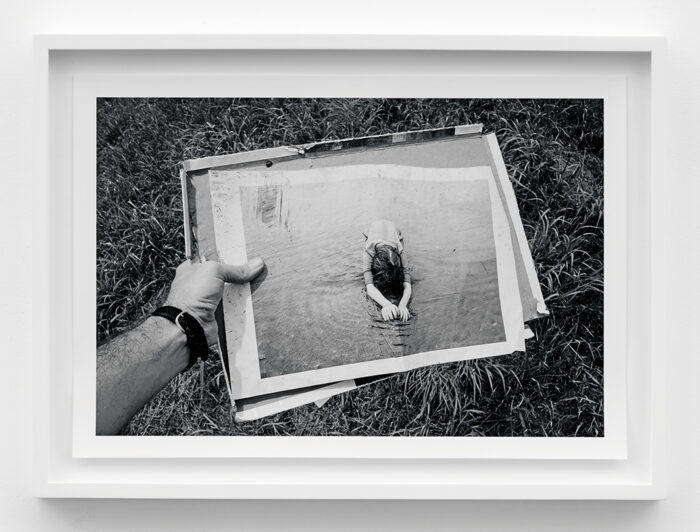
Every picture tells—no, needs a story. The eleven mostly black-and-white photographs (and a zine-like publication assembled from photocopies) that made up “Drift,” Barry Stone’s solo exhibition here, are striking enough at first sight—but they’re also mysterious, both individually and as an ensemble. Water is a recurring element: as the backdrop for the hands holding the vulnerable-looking little sea creature in Hermit Crab, Bailey Island, Maine, 2018, or the substance on which a couple of kids back-float in Floating, Birmingham, Alabama, 2018. In Rainbowed Seaweed, Bailey Island, Maine, 2017–20, we see no figurative presence, just the strangely scrambled-looking wave patterns with subtle resonances of color here and there. Water can even be conspicuous by its absence: Why, for instance, in Floating on the Grass, Bailey Island, Maine, 2018, is that girl ensconced in an inflatable lounger not in a pool but on a wide expanse of lawn? But then some of the works depart from this theme, as does Road Marks, US I-59 Outside Fort Payne, Alabama, 2018, which images skid tracks going off into the distance and crossing the broken white line of the highway.
Some of the images are meta-images, and with these the titles start to give some clues as to the show’s backstory: Take Box of Prints Thrown from the Car, US I-59 Outside Fort Payne, Alabama, 2018, in which a hand holds up a bashed and scuffed-up photograph of a kneeling kid prostrate in shallow water, framed, so to speak, by half of an equally damaged storage box. This image connects to Truck Driver’s Wife Picks Up Prints, US I-59 Outside Fort Payne, Alabama, 2018, in which a woman, her hands full of paper and cardboard, stoops by the roadside to pick up some more. But the full explanation comes only in the gallery press release: The images record, as we learn,
a car accident Stone’s family survived while on a summer road trip from their home in Austin, Texas, to Bailey Island, Maine. In addition to smashing the family car, the crash caused a portfolio of Stone’s photographs taken the previous summer to scatter across the highway. . . . Stone at once began photographing the scene of the accident, and as the family resumed their journey north, he continued to take pictures of their trip.
It would be too facile but not entirely wrong to read this story as a reiteration of the old saw about lemons and lemonade—a demonstration of the necessary resilience and resourcefulness elicited by the artmaking impulse. Of course, the ability to recover is also dependent on luck: That Stone could think of using his camera in the wake of the collision suggests that, thank goodness, no one was badly hurt. In any case, the tone of these works is hardly one of triumph, or even of relief at having escaped a worse fate. What unites the images made after the accident—those taken at the scene, and the ones created earlier, then reworked—is a mood that is pensive and a worldview in which people, like hermit crabs, seem quite small, isolated, and (this is not a photography pun) exposed. The photos show bodies, but faces are hardly to be seen, which I think implies that existence is not locked into the illusory security of identity. Living life and making art mean being caught up in a fluid medium, one not under control, and staying with it.